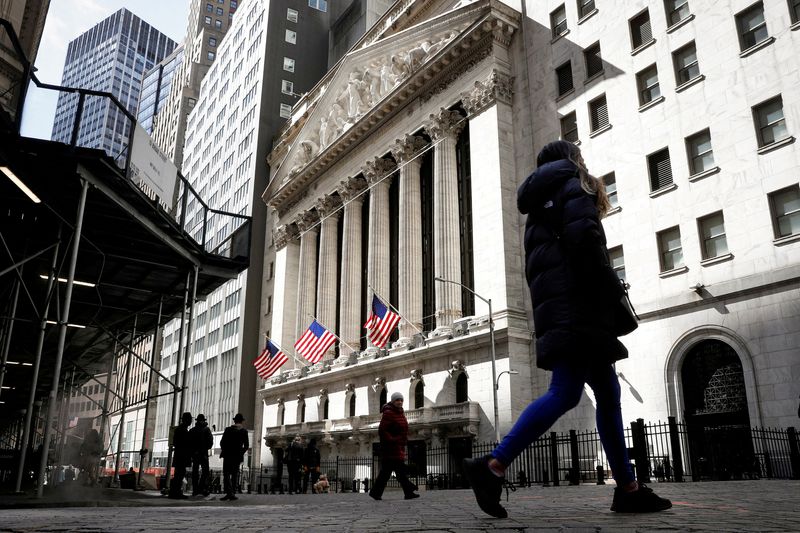By Mike Dolan
LONDON (Reuters) -The Ghost of Christmas Past - a spectral warning from yesteryear in Charles Dickens' A Christmas Carol - may need to be invoked by some investors to parse the spooks of the year ahead.
Understanding properly what went wrong with some the wayward consensus calls of one year ago - notably bets on a falling dollar and rising long-term U.S. bond yields - is now make-or-break for many asset managers peering into 2022.
On the face of it, a uniformly bullish tilt last year toward a booming 2021 for world stocks was bang on the money as COVID-19 vaccines and fiscal spending promises of newly-elected Democrats in Washington encouraged wholesale reflation trades.
Reuters polls last December posited 2021 gains of 9-10% for Wall St and European equities. In the event U.S. indices more than doubled that gain while euro stocks matched the call.
That's probably less impressive when you consider MSCI's all-country stocks index has only recorded 9 negative years in its 35-year history. And, for the record, Reuters latest polls see another 5-7% gain on average next year, even more in Japan.
But under the bonnet, it was a far messier year for macro market forecasters and investor positioning as many underestimated both the strength and durability of the post-pandemic inflation spike as well as the Fed's second-half reaction to it.
The standout bum steer was an overwhelmingly bearish consensus on the U.S. dollar, which has roared higher across the world since mid-year - seeding another dire underperformance in emerging market equities that many widely assumed would be the stars of post-pandemic recovery.
Fund managers polled by Bank of America (NYSE:BAC) this time last year had their highest net allocation to emerging markets since 2010 and 60% of those polled said they would be best performers of the year.
Similarly on the dollar, the net percentage of BofA poll respondents expecting it to depreciate this year was near its highest since 2007. And at the turn of the year, speculative net positioning in the dollar captured by weekly CFTC data was at its most negative in almost 10 years.
And yet the dollar's DXY index gained 7% through the year.
STEEPENERS FALL FLAT
The other big misplaced assumption from a year ago was that racing growth, rising inflation and a flexible Fed happy to run the economy hot would steepen yield curves as 10-year Treasury yields topped 2% and beyond.
According to the December 2020 BofA poll, there was a record net 76% of investors expecting a steeper U.S. yield curve this year - higher than after the 2008 Lehman bust, the 2013 Fed taper tantrum and 2016 U.S. election.
But while long yields did rise, the move burnt itself out by the end of March and key slices of the Treasury yield curve are now either same or flatter than they were a year ago.
Ten-year Treasury yields of just 1.47% remain about 30 basis points below the March peak into a yearend even as the Federal Reserve starts to wind down its bond buying and U.S. inflation stalks 7%. Head scratching about everything from low "natural" levels of interest rates that limit the "terminal" rate of a Fed hiking cycle to technical behaviour of pension funds abound.
Whatever the answer, the quick subsidence of long-term bond yields helped keep faith in Big Tech equity - considered the "most crowded trade" this time last year.
In defence of the calls, it's fair that 12-month forecasts are always a stab in the dark in often volatile financial markets as so much can change mid-year and getting 3-6 months correct is no mean feat for a dynamic exercise anyhow.
But investors trying to make sense of the forecast misses blame a mix of Fed bond buying and growing market belief that so-called Modern Monetary Theory - where government borrows to spend freely and the central bank buys the debt - is now mainstream.
If the Fed won't allow nominal bond yields to rise and destabilise financial markets, higher inflation assumptions can only be expressed in ever more deeply negative real yields - currently near record lows of -1.0% on a 10-year horizon.
"We know how to invest in times of inflation like the 1970s - but how do you invest in a period of financial repression?" JPMorgan (NYSE:JPM) Asset Management's fixed income chief Bob Michele told Reuters Investment Outlook summit this week. "There's a lot of concern and a lot of confusion across the curve."
Franklin Templeton's Chief Investment Officer for fixed income Sonal Desai agreed and reckons bonds are battling both extreme valuations and the "moral hazard" that everyone assumes the Fed will "save the day" on even the slightest wobble in financial markets.
For Neuberger Berman's multi-asset chief Erik Knutzen, the fact that a lot of consensus trades basically topped out by the end of March showed we're in a world where you need to be able to rotate quickly
And he added, that's not going to end: "Investing through an MMT-style negative real rate environment will lead to significant volatility."
For the record, the consensus forecasts for 2022 sees higher equities, a higher dollar and higher bond yields. It's just never as simple as that.
(by Mike Dolan, Twitter (NYSE:TWTR): @reutersMikeD; editing by David Evans)
